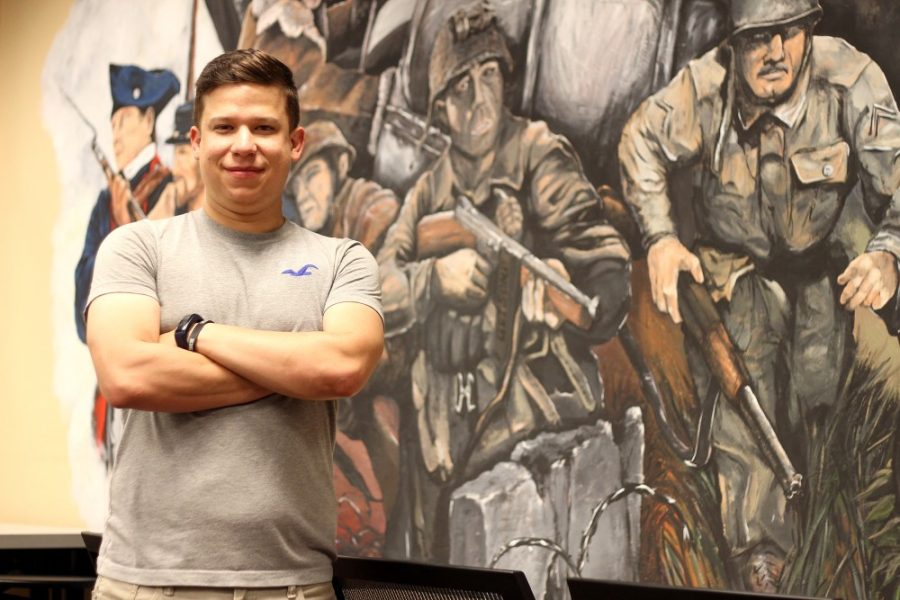Army veteran Kyle James, 29, served as a combat medic for eight years and is now a Veterans Educations and Transition Services peer advocacy liaison, tasked with the responsibility of easing veterans’ transition from military service to academic life.
“I wish I’d had something like that when I first came to the UA,” he said. “I was this 28-year-old guy in a room full of 19-year-olds, and I felt out of place.”
James’ own transition as a student began in 2014 after he got out of the military and went through a divorce, an apparently extremely common occurrence for veterans.
Young people going into the military are better able to provide for families, so the idea of getting married and having children is attractive to them, James explained.
“They don’t realize the trade-off is having to get married too early,” he said.
James spent two years studying at a community college in Chandler, Arizona and made the switch to the UA when he heard about the science department.
At the UA, he studies microbiology with a minor in biochemistry.
“The fascination with biology happened when I took Bio 181,” he said. “I had a lot of clinical experience in the army and was fascinated by viruses.”
James had always known he wanted to go to college to study medicine but didn’t know how he would pay for it. His parents were both in the military during his childhood, and this familiarity led him to join the army at age 17.
“I wanted to do something crazy,” he said. “I wanted to change my life and be a part of something bigger than myself.”
His time spent as a young combat medic in the army taught James the importance of time management, compassion and love.
RELATED: VETS Center introduces peer program to help veterans make transition from military life to academia
“What a culture shock,” he said. “You go from taking life not too seriously to all of the sudden now you have to take every minute of your life seriously or there are terrible consequences.”
From witnessing the death of a 5-year-old to being deployed to Iraq, James experienced many hardships in his eight years serving in the army.
Having these experiences made it easier for James to transition to the UA than an out-of-state student moving away from home, he explained.
“It was still hard, though,” he said. “I had to figure out my own solutions, and now through PALS, veterans don’t have to do that.”
Answers about GI Bill inquiries and certifying classes were difficult for James to find during his transition to being a UA student.
“One of the most difficult things was understanding how my GI Bill transferred,” he said. “If the VETS Center hadn’t connected me with Veteran Services, I would have been lost, and even then I didn’t know if I needed to talk to my adviser or how to find answers or somebody to explain the process to me.”
PALS has already given multiple veterans the information they need to make the transfer to the UA next semester.
“When you go to campus after spending years in the military and get to a college campus, it may be your first time in that area,” said Steve Westby, VETS director of mentor services. “Veterans struggle to adapt, and part of the focus of PALS is to introduce them to our space and resources.”
PALS will be new student veterans’ guide at the UA.
“It could be showing them the benefits they can take advantage of or simply walking someone up here and saying ‘this is your space, too,’” Westby said.
When James saw the opening for student veteran liaison, he knew it was exactly what needed to happen for veterans transferring to the UA.
RELATED: VeloVets provides cycling opportunities for all
According to James, there are currently 2,800 veteran and military-affiliated students at the UA. Next semester alone, the VETS Center is expecting an additional 2,600 to enroll.
“We’ve been steadily growing every year,” he said. “We may have to expand very soon.”
According to Nick Hawley, a fellow peer liaison, the growth is why it is now more important than ever to implement a way to aid veteran students.
“In general, veterans feel pretty disconnected from mainstream society,” Hawley said. “We want to ensure the academic success of veterans and dependents.”
If James had access to the PALS program when he first transferred, he would have saved himself a lot of time and stress, he said.
“I would have had my GI Bill sorted out, gotten my registration fee paid for sooner, would have met with my advisor and signed up for classes way sooner,” he added. “It was a rough start, but now we will be helping veterans so they don’t have to go through that.”
As veterans have more experience and tend to be older than the average student, the veterans working with the PALS program want UA veterans to know they do not need to be alone through their transition from the military to academia.
Next semester, PALS will officially commence, helping veterans like James become well-informed about their options. For the men and women who spent years of their lives in the military and come to the UA to get a better education, the program is highly anticipated.
“We know veterans have issues just like everyone else,” James said. “They want to suck it up and drive on, or they think it’s normal. We want them to know it isn’t bad or weak to ask for help during this transition. It shows strength.”
Follow Jessica Blackburn on Twitter.










